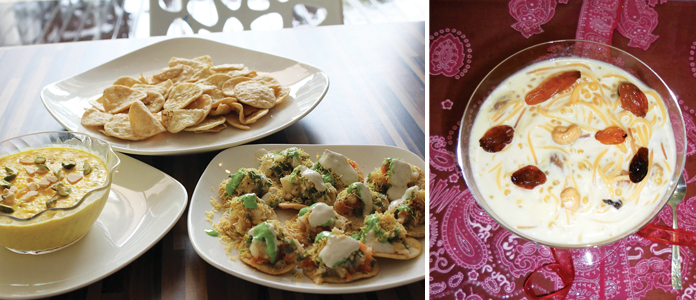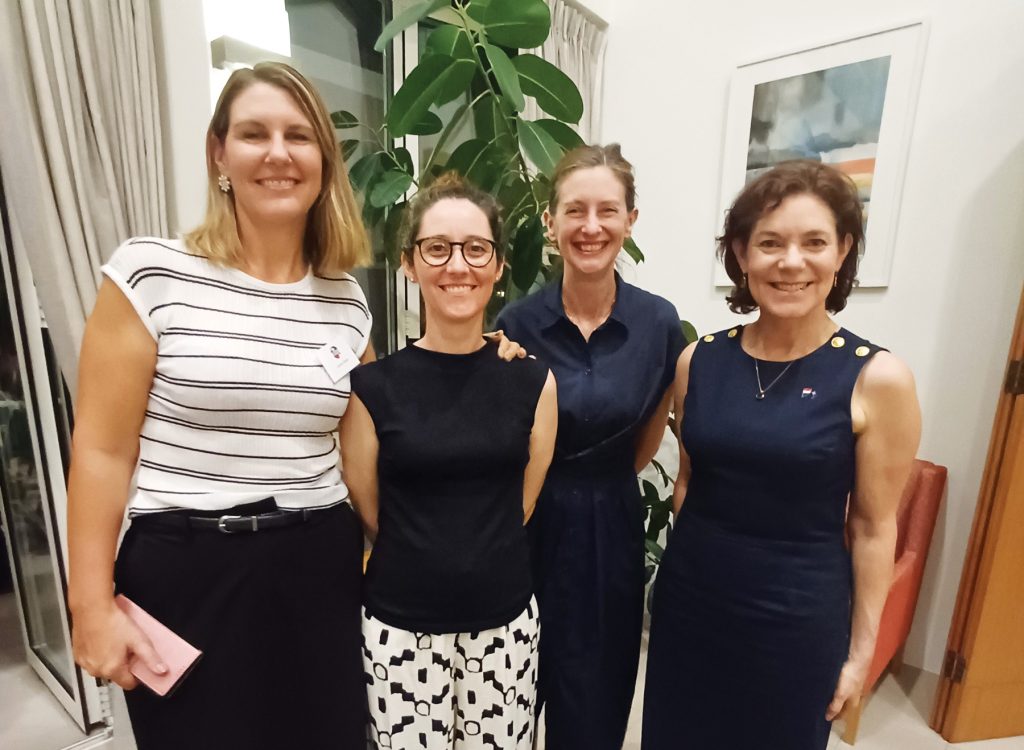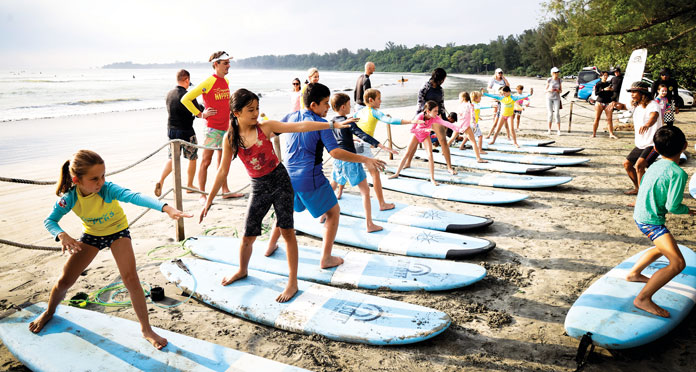 “Our school pedagogy revolves around nature and the outdoors”
“Our school pedagogy revolves around nature and the outdoors”
SCHOOL NAME: Adventure Tree Preschool
STUDENT AGE: 2 months – 6 years old
PRESCHOOL PHILOSOPHY:Adventure Tree Preschool’s play-based approach is grounded in fostering a lifelong love of learning in every student, while nurturing self-esteem, integrity, and a respectful attitude towards others. The curriculum encourages children to discover, create, and imagine, providing a supportive environment for questioning, problem solving, and critical thinking. Learning extends beyond academics, promoting holistic development through play.
STUDENT-TEACHER RATIO:1:3 for infant care (under 17 months); 1:10 for Kindergarten (6 years).
LEARNING & ACTIVITIES: We take a seamless, integrated approach to learning using real-life materials and resources, making education come alive both inside and outside the classroom. Our pedagogy revolves around nature and the outdoors. We believe placing nature at the centre of a child’s education is crucial.
PARENT COMMUNICATION: We maintain open communication through the LittleLives app, enabling parents to stay in touch with teachers, view photos of school drop-offs and pick-ups, and access bi-weekly updates on select activities. We also hold bi-annual parent-teacher meetings.
CONTACT DETAILS:
Katong: 4 Crescent Road, S439289
Braddell: 45A Carmichael Road, S359826
Bukit Timah: 59 Yuk Tong Avenue, S596360
Holland: 9 Grove Drive, S279050
Tel: 9012 6315
[email protected]
“Activities provide an engaging and enriching educational experience”
SCHOOL NAME: Little Paddington Preschool
STUDENT AGE: Infant Care: 3 – 17 months (selected centres); Preschool: 18 months – 6 years (all centres)
PRESCHOOL PHILOSOPHY:Little Paddington Preschool follows a child-centred, play-based philosophy that fosters creativity, social skills, and cognitive development. The curriculum emphasises structured and unstructured play, promoting social-emotional growth through collaborative activities. It integrates early literacy and numeracy into daily routines, encourages outdoor exploration, and includes diverse cultural experiences to promote inclusivity.
STUDENT-TEACHER RATIO:
- Infant Care (Little Cubbies): 1:3
- Playgroup (Little Winnies): 1:6
- Nursery 1 (Grizzlies 1): 1:8
- Nursery 2 (Grizzlies 2): 1:10
- Kindergarten 1 (Giant Panda 1): 1:12
- Kindergarten 2 (Giant Panda 2): 1:14
LEARNING & ACTIVITIES:
- Creative Arts
- Science Experiments
- Culinary Activities
- Outdoor Exploration
- Storytelling and Literacy
- STEM Activities
- Show and Tell
- United Nations Programs
- Social-Emotional Learning
- Physical Activities
- Each activity is designed to provide a balanced, engaging, and enriching experience, catering to the diverse needs of preschoolers while promoting their overall development.
DAILY SCHEDULE: Children begin with free play to socialise and settle in, followed by the Be-Pawsitive Morning Assembly, fostering a positive mindset. Circle Time includes discussions, songs, and movement, while Jolly Music introduces rhythm and melody. Structured learning covers literacy, numeracy, and hands-on experiences in art, science, and sensory play. The Paddington Prep Program develops essential primary school skills. Children also enjoy Atelier classes in arts, cookery, and science, plus immersive Mandarin learning through activities like Panda Village. Story Time and Jolly Phonics support bilingual literacy, and outdoor play promotes physical exploration.
PARENT COMMUNICATION: We maintain clear communication with parents through the LittleLives app. Each Friday, we send a comprehensive weekly overview, highlighting key activities from the past week and previewing what’s coming up.
CONTACT DETAILS:
“Each classroom is staffed with one English and one Mandarin-speaking educator”
SCHOOL NAME: St. Joseph’s Institution International Preschool
STUDENT AGE: 3 – 6 years
PRESCHOOL PHILOSOPHY: At SJI International Preschool, we prioritise collaborative exploration, dialogue, and shared meaning-making. Children engage in real-world experiences, constructing knowledge through questioning, investigating, and reflecting with peers and educators. We provide structured components for English Literacy, Mandarin Literacy, and Numeracy to ensure progress and success.
STUDENT-TEACHER RATIO: In Early Years 1, the ratio is 1:8 to ensure personalised care. The ratio adjusts to 1:12 in Early Years 2 and 1:16 in Kindergarten 1 and 2, promoting individual attention and peer collaboration.
LEARNING & ACTIVITIES: SJI International Preschool offers a comprehensive bilingual English and Mandarin Immersion programme, with each classroom staffed by at least one English and one Mandarin-speaking educator. Our outdoor learning programme promotes sustainability, citizenship, and life skills like self-reliance and leadership. Activities such as urban farming offer eco-conscious perspectives, while adventurous play empowers children to assess and manage risks.
DAILY SCHEDULE: The core programme runs from 9am – 5pm, beginning with mixed-age group interactions to foster social skills. After breakfast, children enjoy Circle Time with songs and discussions, followed by music, movement, and outdoor play. Bilingual learning is integrated throughout the day with immersive inquiry and learning space exploration. After lunch and storytime, a calming rest period follows. The afternoon includes more bilingual activities and character-building sessions, with the day ending in mixed-age interactions.
PARENT COMMUNICATION: We share regular updates on each child’s progress, development, and special moments via our school management system. We also encourage open communication through face-to-face conversations during pick-up and drop-off, email, and phone calls. In-depth parent-teacher conferences are held three times a year.
CONTACT DETAILS:
49A Holland Road, Singapore, 258850
+65 6908 4520
[email protected]


 “Our school pedagogy revolves around nature and the outdoors”
“Our school pedagogy revolves around nature and the outdoors” A
A
 D
D
 W
W
 ONLY HAVE EYES FOR YOU
ONLY HAVE EYES FOR YOU  BE MY VALENTINE
BE MY VALENTINE  BECAUSE I SAID SO
BECAUSE I SAID SO  I’M GOING TO MARRY THE CREPE OUT OF YOU with Sunny Eggs & Ham
I’M GOING TO MARRY THE CREPE OUT OF YOU with Sunny Eggs & Ham  CHERYL MILES is the founder of
CHERYL MILES is the founder of 





 Fysh
Fysh Enso Steakhouse
Enso Steakhouse Coastes
Coastes The Prince Singapore
The Prince Singapore Wildseed at 1-Flowerhill, Sentosa
Wildseed at 1-Flowerhill, Sentosa Firangi Superstar
Firangi Superstar SUSHISAMBA
SUSHISAMBA Wolfgang’s Steakhouse Singapore
Wolfgang’s Steakhouse Singapore Tanglin Cookhouse
Tanglin Cookhouse Vue Bar & Grill
Vue Bar & Grill KOMA Singapore
KOMA Singapore Ryan’s Kitchen
Ryan’s Kitchen  Courtyard by Marriott Singapore Novena
Courtyard by Marriott Singapore Novena S
S




 The Brand New Heavies hit Singapore
The Brand New Heavies hit Singapore The ANZA Black Tie Ball 2025 – Tickets on sale now!
The ANZA Black Tie Ball 2025 – Tickets on sale now!
 Waitangi Day Family Celebrations 2025
Waitangi Day Family Celebrations 2025
 Ring it in
Ring it in Per°Form Open Academy of Arts and Activations 2025 (POA 2025)
Per°Form Open Academy of Arts and Activations 2025 (POA 2025)
